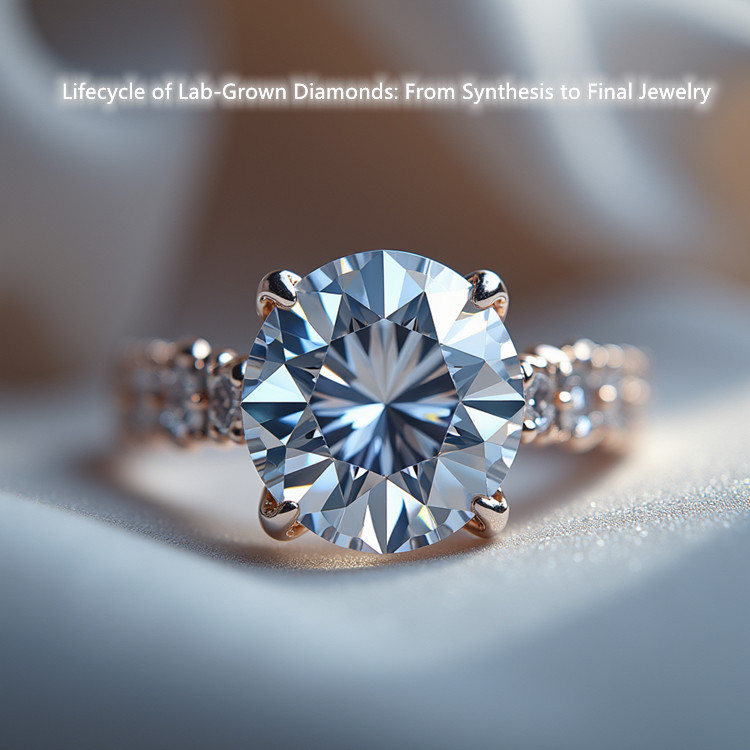
The Lifecycle of Diamonds: From Cultivation to Finished Jewelry
Introduction
Diamonds have captivated humanity for centuries. Their allure lies not only in their breathtaking beauty but also in the intricate process that transforms raw carbon into sparkling gemstones. The journey of a diamond from cultivation to its final form as exquisite jewelry is a story of technology, artistry, and craftsmanship. This article will delve into each stage of this lifecycle, highlighting the advancements that continue to shape the diamond industry today.
1. The Cultivation of Diamonds
The journey of a diamond begins deep beneath the Earth’s surface, where carbon is subjected to extreme heat and pressure over millions of years. However, with the advent of technology, the cultivation of diamonds has taken a new turn. Two primary methods are now used to create synthetic diamonds: High Pressure High Temperature (HPHT) and Chemical Vapor Deposition (CVD).
1.1 High Pressure High Temperature (HPHT)
The HPHT method replicates the natural conditions under which diamonds form. A small diamond seed is placed in a chamber with carbon and subjected to intense heat (over 1,400 degrees Celsius) and pressure (about 5 GPa). The carbon then melts and crystallizes around the seed, eventually forming a diamond. This technique has been refined over the years, leading to higher quality diamonds that closely mimic natural gems.
1.2 Chemical Vapor Deposition (CVD)
CVD is a newer technology that has gained popularity for its ability to produce high-quality diamonds more efficiently. In this process, a hydrogen and methane gas mixture is introduced into a vacuum chamber. The gases are ionized, allowing carbon atoms to deposit onto a substrate, layer by layer, eventually forming a diamond. CVD diamonds are celebrated for their clarity and lack of impurities, making them an attractive choice for both jewelers and consumers.
2. Cutting: Transforming Rough into Radiance
Once a diamond has been cultivated, it must be cut to bring out its beauty. This step is crucial, as the cut determines how light interacts with the diamond, affecting its brilliance and sparkle. Gemologists assess the rough diamond, considering factors such as size, shape, and inclusions. The cutting process involves several steps, each requiring precision and expertise.
2.1 Planning the Cut
Before cutting begins, skilled gemologists perform a thorough examination of the rough diamond using advanced imaging technology. They create meticulous plans to maximize yield and minimize waste. This stage is critical, as it sets the foundation for the finished product.
2.2 Sawing and Cleaving
The rough diamond is then cut into smaller pieces using laser saws or mechanical cleaving. Laser technology has transformed this step, allowing for more accurate cuts that preserve the stone’s integrity. The goal is to create a manageable size for further shaping while retaining as much of the diamond’s weight as possible.
2.3 Shaping and Faceting
The diamond is shaped into its final form through a process called bruting. This involves grinding the stone against another diamond to form a rounded shape. Once the basic shape is achieved, faceting begins. Each facet is cut at a specific angle to enhance the diamond’s reflections and refractions. Modern diamond cutting utilizes computer-aided design (CAD) software to ensure precision, resulting in perfectly aligned facets.
2.4 Final Polish
After faceting, the diamond undergoes a final polishing to achieve its dazzling shine. This step is performed using a rotating wheel coated with diamond dust. Skilled artisans monitor the process closely to ensure the highest quality finish, contributing to the diamond's overall allure.
3. Crafting Jewelry: From Stone to Masterpiece
With the diamond cut and polished, the next step is to transform it into a piece of jewelry. This stage involves a blend of creativity, functionality, and craftsmanship.
3.1 Design Process
Jewelry design is an art form that requires a deep understanding of aesthetics and functionality. Jewelers use sketches, computer software, and even 3D printing to create models of their designs. This innovative approach allows for greater creativity while ensuring that the final piece meets the highest standards.
3.2 Selecting Materials
The choice of metal and additional stones is critical in jewelry design. Platinum, gold, and silver are popular choices for settings, each offering distinct characteristics. Jewelers also consider the diamond's color, cut, and clarity when selecting complementary stones that enhance its beauty.
3.3 Craftsmanship and Setting
The actual crafting of the jewelry piece is where skilled artisans truly shine. Using a combination of traditional techniques and modern technology, they meticulously assemble the components. The diamond is securely set in a way that optimizes its visibility and protects it from damage. Common settings include prong, bezel, and pave settings, each contributing to the overall design's aesthetic.
3.4 Quality Control
Before a piece of jewelry is deemed complete, it undergoes rigorous quality control checks. Jewelers inspect the setting, polish, and overall craftsmanship to ensure that every detail meets their exacting standards. Any necessary adjustments are made at this stage, guaranteeing that the piece is flawless.
4. Advances in Technology and Innovation
The diamond industry has witnessed significant technological advancements in recent years. These innovations not only enhance the quality of diamonds but also improve the overall experience for consumers and jewelers alike.
4.1 Laser Technology
Laser technology has revolutionized the cutting process, allowing for precision and speed. Laser tools can cut through diamonds with unrivaled accuracy, reducing waste and maximizing yield. This technology is also used in engraving details onto the diamond, adding a unique touch to custom pieces.
4.2 Computer-Aided Design (CAD)
CAD software has become an invaluable tool in jewelry design. It allows designers to visualize their creations in 3D, making alterations easily before production begins. This technology streamlines the design process and minimizes the risk of errors.
4.3 Sustainability and Ethical Practices
As consumer awareness grows, there is a heightened focus on sustainability and ethical sourcing within the diamond industry. Lab-grown diamonds have emerged as a popular alternative to mined stones, offering an eco-friendly and conflict-free option. Additionally, many jewelers are now committed to ethical sourcing practices, ensuring transparency throughout the supply chain.
4.4 Blockchain Technology
Blockchain technology is now being explored to ensure traceability and authenticity. By recording each diamond's journey on a blockchain, consumers can verify the stone's origin and ethical impact. This initiative builds trust and confidence in the diamond purchasing process.
Conclusion
The lifecycle of a diamond, from its cultivation to its transformation into stunning jewelry, is a testament to the incredible interplay between nature, technology, and artistry. As advancements continue to shape the diamond industry, the future holds promising possibilities for enhancing both quality and sustainability. Whether it’s a lab-grown diamond or a meticulously crafted piece of jewelry, the story of each diamond is a reflection of human ingenuity and creativity.
Through this detailed exploration, we gain a deeper appreciation for the complexities involved in each step of the diamond's journey. The next time you admire a diamond, remember the remarkable processes and innovations that brought it to life.










